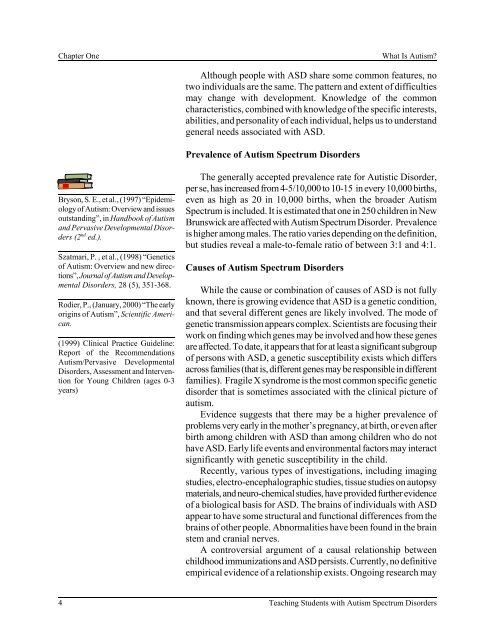Teaching Students with Autism Spectrum Disorders
Teaching Students with Autism Spectrum Disorders
Teaching Students with Autism Spectrum Disorders
You also want an ePaper? Increase the reach of your titles
YUMPU automatically turns print PDFs into web optimized ePapers that Google loves.
Chapter One What Is <strong>Autism</strong>?<br />
Bryson, S. E., et al., (1997) “Epidemiology<br />
of <strong>Autism</strong>: Overview and issues<br />
outstanding”, in Handbook of <strong>Autism</strong><br />
and Pervasive Developmental <strong>Disorders</strong><br />
(2 nd ed.).<br />
Szatmari, P. , et al., (1998) “Genetics<br />
of <strong>Autism</strong>: Overview and new directions”,<br />
Journal of <strong>Autism</strong> and Developmental<br />
<strong>Disorders</strong>, 28 (5), 351-368.<br />
Rodier, P., (January, 2000) “The early<br />
origins of <strong>Autism</strong>”, Scientific American.<br />
(1999) Clinical Practice Guideline:<br />
Report of the Recommendations<br />
<strong>Autism</strong>/Pervasive Developmental<br />
<strong>Disorders</strong>, Assessment and Intervention<br />
for Young Children (ages 0-3<br />
years)<br />
Although people <strong>with</strong> ASD share some common features, no<br />
two individuals are the same. The pattern and extent of difficulties<br />
may change <strong>with</strong> development. Knowledge of the common<br />
characteristics, combined <strong>with</strong> knowledge of the specific interests,<br />
abilities, and personality of each individual, helps us to understand<br />
general needs associated <strong>with</strong> ASD.<br />
Prevalence of <strong>Autism</strong> <strong>Spectrum</strong> <strong>Disorders</strong><br />
The generally accepted prevalence rate for Autistic Disorder,<br />
per se, has increased from 4-5/10,000 to 10-15 in every 10,000 births,<br />
even as high as 20 in 10,000 births, when the broader <strong>Autism</strong><br />
<strong>Spectrum</strong> is included. It is estimated that one in 250 children in New<br />
Brunswick are affected <strong>with</strong> <strong>Autism</strong> <strong>Spectrum</strong> Disorder. Prevalence<br />
is higher among males. The ratio varies depending on the definition,<br />
but studies reveal a male-to-female ratio of between 3:1 and 4:1.<br />
Causes of <strong>Autism</strong> <strong>Spectrum</strong> <strong>Disorders</strong><br />
While the cause or combination of causes of ASD is not fully<br />
known, there is growing evidence that ASD is a genetic condition,<br />
and that several different genes are likely involved. The mode of<br />
genetic transmission appears complex. Scientists are focusing their<br />
work on finding which genes may be involved and how these genes<br />
are affected. To date, it appears that for at least a significant subgroup<br />
of persons <strong>with</strong> ASD, a genetic susceptibility exists which differs<br />
across families (that is, different genes may be responsible in different<br />
families). Fragile X syndrome is the most common specific genetic<br />
disorder that is sometimes associated <strong>with</strong> the clinical picture of<br />
autism.<br />
Evidence suggests that there may be a higher prevalence of<br />
problems very early in the mother’s pregnancy, at birth, or even after<br />
birth among children <strong>with</strong> ASD than among children who do not<br />
have ASD. Early life events and environmental factors may interact<br />
significantly <strong>with</strong> genetic susceptibility in the child.<br />
Recently, various types of investigations, including imaging<br />
studies, electro-encephalographic studies, tissue studies on autopsy<br />
materials, and neuro-chemical studies, have provided further evidence<br />
of a biological basis for ASD. The brains of individuals <strong>with</strong> ASD<br />
appear to have some structural and functional differences from the<br />
brains of other people. Abnormalities have been found in the brain<br />
stem and cranial nerves.<br />
A controversial argument of a causal relationship between<br />
childhood immunizations and ASD persists. Currently, no definitive<br />
empirical evidence of a relationship exists. Ongoing research may<br />
4 <strong>Teaching</strong> <strong>Students</strong> <strong>with</strong> <strong>Autism</strong> <strong>Spectrum</strong> <strong>Disorders</strong>

















